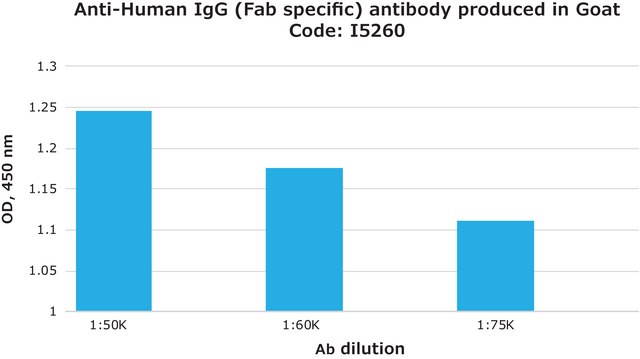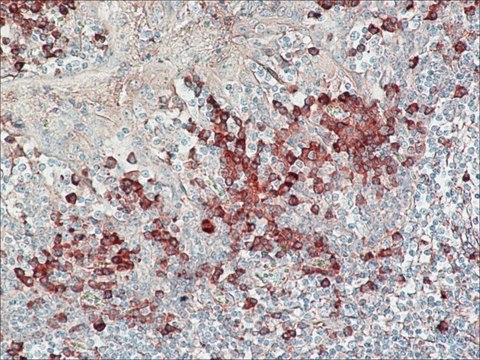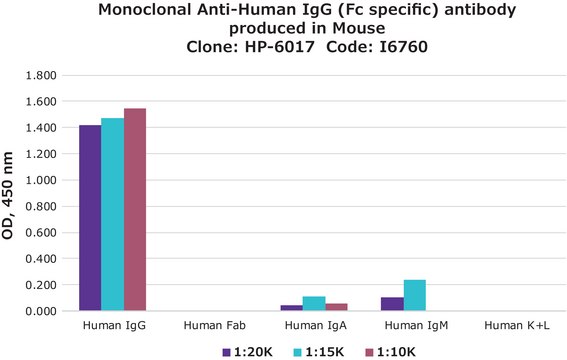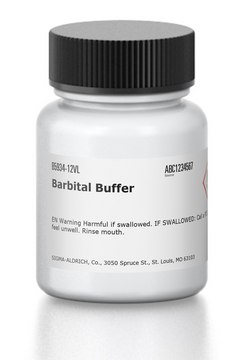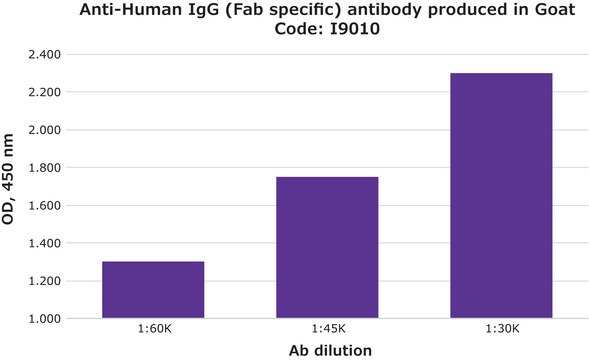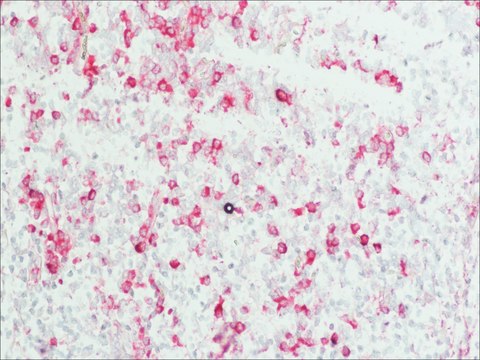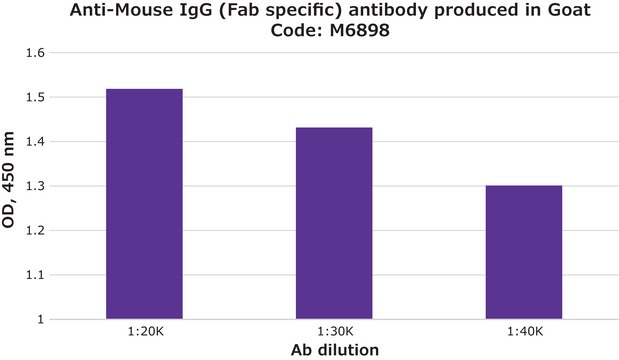I6135
Monoclonal Anti-Human IgG (Fab specific) antibody produced in mouse
clone GG-6, ascites fluid
Sign Into View Organizational & Contract Pricing
All Photos(1)
About This Item
Recommended Products
biological source
mouse
Quality Level
conjugate
unconjugated
antibody form
ascites fluid
antibody product type
primary antibodies
clone
GG-6, monoclonal
contains
15 mM sodium azide
technique(s)
indirect ELISA: 1:20,000
isotype
IgG1
shipped in
dry ice
storage temp.
−20°C
target post-translational modification
unmodified
General description
Human IgGs are glycoprotein antibodies that contain two equivalent light chains and a pair of identical heavy chains. IgGs have four distinct isoforms, ranging from IgG1 to IgG4. Monoclonal Anti-Human IgG (Fab specific) antibody is specific for the Fab fragment of human IgG. The antibody does not react with the Fc portion of human IgG.
Monoclonal Anti-Human IgG (Fab Specific) (mouse IgG1 isotype) is derived from the hybridoma produced by the fusion of mouse myeloma cells and splenocytes from an immunized mouse. Immunoglobulin G (IgG) is found in the blood. It is present in the human serum, secreted by the B cells. IgG has the lengthiest serum half-life compared to other immunoglobulins. Heavy and light chains of IgG are interconnected by disulfide bonds.
Specificity
Monoclonal Anti-Human IgG (Fab Specific) is immunospecific for human IgG. The antibody reacts with the Fab fragment of IgG.
Immunogen
Purified human IgG
Application
Monoclonal Anti-Human IgG (Fab specific) antibody produced in mouse has been used in enzyme-linked immunosorbent assay (ELISA).
Biochem/physiol Actions
Maternal IgG passes through the placenta to the fetus and confers immune defense of the neonate against infections. IgG is implicated in antibody-dependent cell-mediated cytotoxicity (ADCC) and also nullifies virus particles and toxins. Papain digestion of IgG generates fragment antigen-binding (Fab). Pepsin digestion of IgG produces fragment crystallizable (fc) fragment and a single dimeric F(ab)2.
These antibodies regulate immunological responses to allergy and pathogenic infections. IgGs have also been implicated in complement fixation and autoimmune disorders.
Physical form
The product is provided as ascites fluid with 0.1% sodium azide (see MSDS) as a preservative.
Storage and Stability
For continuous use, store at 0-5 °C. For extended storage, solution may be frozen in working aliquots. Repeated freezing and thawing is not recommended. Storage in "frost-free" is not recommended. If slight turbidity occurs upon prolonged storage, clarify by centrifugation before use.
Disclaimer
Unless otherwise stated in our catalog or other company documentation accompanying the product(s), our products are intended for research use only and are not to be used for any other purpose, which includes but is not limited to, unauthorized commercial uses, in vitro diagnostic uses, ex vivo or in vivo therapeutic uses or any type of consumption or application to humans or animals.
Not finding the right product?
Try our Product Selector Tool.
Storage Class Code
10 - Combustible liquids
WGK
nwg
Flash Point(F)
Not applicable
Flash Point(C)
Not applicable
Regulatory Information
常规特殊物品
Choose from one of the most recent versions:
Certificates of Analysis (COA)
Lot/Batch Number
Don't see the Right Version?
If you require a particular version, you can look up a specific certificate by the Lot or Batch number.
Already Own This Product?
Find documentation for the products that you have recently purchased in the Document Library.
Mario R Romero et al.
Acta odontologica latinoamericana : AOL, 24(2), 176-182 (2011-12-15)
The aim of this study was to measure the level of immunoglobulin A, G and M in saliva of 3- to 12-year-old children, both healthy and diagnosed with gingivitis. A sample of 177 children was selected, of whom 24 were
Ian P Hurley et al.
Forensic science international, 190(1-3), 91-97 (2009-07-07)
The detection and confirmation of bloodstains as being human in origin is important in crime scene investigations. There are a number of blood detection methods currently available. The aim of this work was to develop an assay capable of detecting
Udayan Ray et al.
Journal of thrombosis and thrombolysis, 33(3), 218-229 (2012-01-13)
Insulin inhibits platelet aggregation through nitric oxide synthesis by stimulating platelet insulin activated nitric oxide synthase. Impaired platelet insulin activated nitric oxide synthase in acute myocardial infarction (AMI) patients had been reported and thus our aim was to identify and
Manuel Montesinos-Rongen et al.
Journal of immunology (Baltimore, Md. : 1950), 195(3), 1312-1319 (2015-06-28)
Primary lymphoma of the CNS (PCNSL) is a diffuse large B cell lymphoma confined to the CNS. To elucidate its peculiar organ tropism, we generated recombinant Abs (recAbs) identical to the BCR of 23 PCNSLs from immunocompetent patients. Although none
C Papadea et al.
Critical reviews in clinical laboratory sciences, 27(1), 27-58 (1989-01-01)
Human IgG consists of two identical heavy (H) chains and two identical light (L) chains joined by interchain disulfide bridges. Heterogeneity in the amino acid sequences of the H and L polypeptides results in at least three types of IgG
Our team of scientists has experience in all areas of research including Life Science, Material Science, Chemical Synthesis, Chromatography, Analytical and many others.
Contact Technical Service